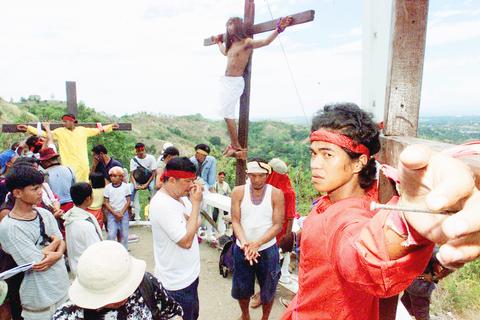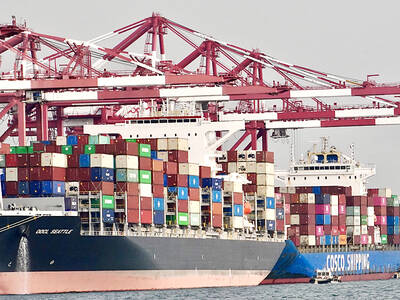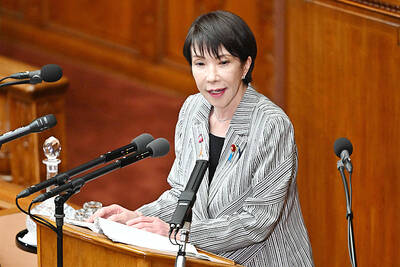Thousands of penitents scaled a hilltop where three members of a Christian cult were nailed to crosses in a Good Friday rite of sacrifice for peace in the war-weary south of the Philippines.
"We are setting an example for sinful people to change so there can be peace," said Jose Felipe, a 24-year-old carpenter and member of the Kristo Rey cult who was undergoing his second crucifixion.
"In war, the civilians are always at the losing end," he said before 10cm nails were driven through his palms as several women mumbled prayers in Latin and Chavacano, the local dialect.

PHOTO: REUTERS
Crucifixions and acts of self-flagellation are regular Easter Lenten rites in the Philippines, and similar scenes played out elsewhere around the country yesterday.
The 200m-high hill overlooks Zamboanga, a predominantly Roman Catholic city of 600,000 people, and the narrow strait that separates it from the island province of Basilan, whose forest-clad mountains loomed on the horizon.
Roel Natividad, a Zamboanga city councillor and Kristo Rey member, said previous crucifixions were done for the spiritual benefit of the group but that this year's rites were sacrifices for peace for Basilan.
A US-backed military operation is under way on Basilan against the Muslim extremist Abu Sayyaf group, which has been holding an American couple and a Filipino nurse for 10 months. They are the last of dozens of hostages snatched last year -- others were freed; some were beheaded.
"We are doing this for peace, but we are ready to defend our city from any group, Muslims or Christians, which will try to foment trouble," Natividad said.
He said his group joined a recent rally to back the counter-terrorism exercise involving 660 US soldiers, including 160 from the Special Forces deployed with front-line Philippine troops on Basilan.
Yesterday's rites were steeped in superstition. Kristo Rey members wore red shirts and headbands with black Latin markings that they said only their leaders could understand. Some had triangles and crosses tattooed on their chests and arms.
The three men grimaced in pain as they were nailed down, with a piece of wood on each cross serving as a footrest. Other cult members raised the crosses using nylon ropes that kept them upright for an hour under a scorching sun.
In the middle was cult leader Winnie de Vera, a 23-year-old government waste-recycling employee, who wore a white robe and a wig for his fourth crucifixion. His head was crowned with a thorny vine.
Apparently, his cross leaned too far forward so the nail in his right palm dislodged from the wood and had to be hammered back in.
"Lean the cross back a little," he instructed his followers.
In the small village of San Pedro Cutud, 70km north of Manila, where crucifixion re-enactments take place annually, 18 people were nailed to crosses. Part solemn ritual, part tourist spectacle, the celebrations drew an estimated 20,000 people this time.
It was the 15th year that Bob Velez, 64, has taken part. He portrays Christ, enhanced by a wig of wiry black hair, a white loincloth and a crown of barbed wire.
"I feel the nail, but not the pain. I am strong in my heart," Velez said as he walked around a small clearing where three wooden crosses had been set up.
When his turn came to be hoisted up onto a cross, a grimace of pain and then a smile crossed his face as 20cm nails were driven through his palms.

The Central Weather Administration (CWA) yesterday said it expected to issue a sea warning for Typhoon Fung-Wong tomorrow, which it said would possibly make landfall near central Taiwan. As of 2am yesterday, Fung-Wong was about 1,760km southeast of Oluanpi (鵝鑾鼻), Taiwan’s southernmost point, moving west-northwest at 26kph. It is forecast to reach Luzon in the northern Philippines by tomorrow, the CWA said. After entering the South China Sea, Typhoon Fung-Wong is likely to turn northward toward Taiwan, CWA forecaster Chang Chun-yao (張峻堯) said, adding that it would likely make landfall near central Taiwan. The CWA expects to issue a land

Taiwan’s exports soared to an all-time high of US$61.8 billion last month, surging 49.7 percent from a year earlier, as the global frenzy for artificial intelligence (AI) applications and new consumer electronics powered shipments of high-tech goods, the Ministry of Finance said yesterday. It was the first time exports had exceeded the US$60 billion mark, fueled by the global boom in AI development that has significantly boosted Taiwanese companies across the international supply chain, Department of Statistics Director-General Beatrice Tsai (蔡美娜) told a media briefing. “There is a consensus among major AI players that the upcycle is still in its early stage,”

‘SECRETS’: While saying China would not attack during his presidency, Donald Trump declined to say how Washington would respond if Beijing were to take military action US President Donald Trump said that China would not take military action against Taiwan while he is president, as the Chinese leaders “know the consequences.” Trump made the statement during an interview on CBS’ 60 Minutes program that aired on Sunday, a few days after his meeting with Chinese President Xi Jinping (習近平) in South Korea. “He [Xi] has openly said, and his people have openly said at meetings, ‘we would never do anything while President Trump is president,’ because they know the consequences,” Trump said in the interview. However, he repeatedly declined to say exactly how Washington would respond in

Japanese Prime Minister Sanae Takaichi said yesterday that China using armed force against Taiwan could constitute a "survival-threatening situation" for Japan, allowing the country to mobilize the Japanese armed forces under its security laws. Takaichi made the remarks during a parliamentary session yesterday while responding to a question about whether a "Taiwan contingency" involving a Chinese naval blockade would qualify as a "survival-threatening situation" for Japan, according to a report by Japan’s Asahi Shimbun. "If warships are used and other armed actions are involved, I believe this could constitute a survival- threatening